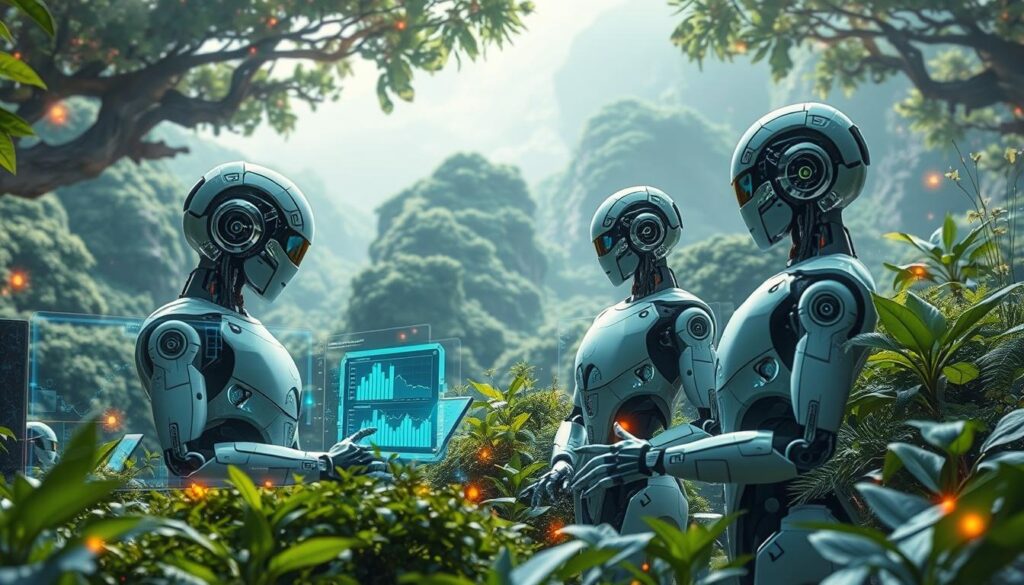Are you ready to unlock the power of the future? Adaptive AI algorithms are changing the game in artificial intelligence. They bring us smarter, more flexible machines. These algorithms learn and grow, adapting to new situations better than old AI methods.
With features like branching logic and parallel processing, adaptive AI is set to solve problems like never before. It will make decisions more accurately and find creative solutions. This marks the start of a new era where machines can handle complex tasks and evolve with our changing world.

Key Takeaways
- Adaptive AI algorithms are revolutionizing the field of artificial intelligence, ushering in a new era of smarter, more versatile machines.
- These algorithms are designed to continuously learn and evolve, adapting to complex and dynamic environments.
- Adaptive AI algorithms unlock unprecedented levels of problem-solving capability, decision-making accuracy, and creative problem-solving.
- The incorporation of features like branching logic, parallel processing, and adaptive reasoning enables these algorithms to thrive in the modern world.
- Adaptive AI represents a significant step forward in the evolution of artificial intelligence, promising a future where machines can adapt and grow alongside the ever-changing needs of society.
- 1 Introduction to Adaptive AI Algorithms
- 2 Tree of Thoughts: A Groundbreaking Approach
- 3 Adaptive AI Algorithms: A New Era of Smarter Machines
- 4 The Evolution of AI: From Static to Adaptive
- 5 Applications of Adaptive AI Algorithms
- 6 Ethical Considerations and Challenges
- 7 The Future of Adaptive AI: Trends and Predictions
- 8 Creating a Comprehensive Tree of Thoughts Dataset
- 9 Conclusion
- 10 FAQ
Introduction to Adaptive AI Algorithms
In the fast-changing world of artificial intelligence, a new method is getting a lot of attention – adaptive AI algorithms. These advanced algorithms learn and adapt continuously. They move beyond the limits of old, static AI models. By using dynamic learning and self-improvement, adaptive AI algorithms are set to change how we solve complex problems and use AI fully.
What are Adaptive AI Algorithms?
Adaptive AI algorithms are a major step forward in machine learning. Unlike old AI, these algorithms can grow and adjust to new situations, data, and goals. They do this with new features like:
- Branching logic: Adaptive AI algorithms can explore many paths at once. This lets them look at more possibilities and make better choices.
- Evaluation and pruning: These algorithms always check the value of each path. They drop paths that don’t look good and focus on the best ones.
- Backtracking: Adaptive AI algorithms can change their plan based on early results. This lets them fix mistakes and try new solutions when needed.
The Importance of Adaptive AI in Modern Computing
The value of adaptive AI algorithms is in solving tough problems that old AI can’t handle. Today, with data and environments always changing, AI needs to be flexible and adaptable. Adaptive AI algorithms can handle these changes, making better choices, finding new solutions, and staying up-to-date.
“Adaptive AI algorithms are revolutionizing the way we approach complex problems, unlocking new possibilities and driving the evolution of artificial intelligence.” – Dr. Emily Harrington, AI Researcher
By using adaptive AI, we can start a new era of smarter, more flexible machines. As the world keeps changing, the role of adaptive AI algorithms will grow. They will shape the future of computing and power many applications in different fields.

Tree of Thoughts: A Groundbreaking Approach
The Tree of Thoughts (ToT) is a new way to make AI smarter. It lets AI systems try many paths at once, like a tree with many branches. This way, AI can look at different options and go back if needed.
Exploring the Key Features of Tree of Thoughts
ToT makes AI better at solving complex problems. It helps AI be more open and effective. This is a big step forward in AI.
Why Tree of Thoughts Matters for AI Development
The Tree of Thoughts dataset is a big project. It aims to have 50,000 examples of complex reasoning. So far, they’ve worked for two days, and they need about five more days to finish.
This dataset will help train AI models that use ToT. It will make this new approach more common and useful.
Each example in the dataset shows how ToT works. It covers many topics and problems. This makes it useful for many situations. The dataset shows both the thought process and the final answer, giving insights into AI’s decisions.
Using the Tree of Thoughts dataset, AI experts can make AI better at AI reasoning, AI problem-solving, and AI creativity. This will lead to a new era of adaptive AI algorithms and AI decision-making.

Adaptive AI Algorithms: A New Era of Smarter Machines
Adaptive AI algorithms are changing the game for smarter machines. They can handle complex situations better than ever before. These advanced algorithms use new features like branching logic and adaptive reasoning.
They are set to change many fields, from healthcare to robotics. This is because they can learn and grow over time. They are more than just static AI models.
The Tree of Thoughts (ToT) dataset project is a big step forward. It aims to have 50,000 entries that show complex reasoning. Each entry is designed to show how the ToT works.
“The ToT approach leads to greater creativity in AI-generated solutions by considering diverse possibilities, and the adaptive reasoning feature allows AI to adjust its approach based on intermediate results, increasing flexibility and solution robustness.”
The Tree of Thoughts dataset will help train AI models. It will teach them to use adaptive AI algorithms better. This means they can solve complex problems more effectively.
This new era of AI promises to open up new possibilities. It will change many industries and help AI solve new challenges.
Adaptive AI algorithms have many uses. They can help in healthcare, medical diagnostics, and even in robotics. These algorithms are more than just smart machines. They can learn and adapt to new situations.
The Evolution of AI: From Static to Adaptive
Artificial intelligence (AI) has changed a lot, moving from simple rules to more complex systems. Old AI methods worked well in some areas but failed in the real world’s complexity.
Limitations of Traditional AI Approaches
Old AI couldn’t learn over time or adapt to changes. It also did poorly in unclear situations. As the world gets more complex, these AI limits are more obvious.
The Need for Adaptability in Complex Environments
New AI, like the Tree of Thoughts, overcomes these issues. It lets machines learn, try different paths, and change plans as needed. This adaptability is key in today’s fast-changing world.
Adaptive AI, like the Tree of Thoughts, is a big step forward. It’s ready for the modern world’s challenges, making machines smarter and more flexible.
“The future of AI lies in its ability to adapt and evolve, not just to follow rigid rules.”
Applications of Adaptive AI Algorithms
Adaptive AI algorithms are changing the game in many fields. They’re making a big splash in healthcare and medical diagnostics, and also in autonomous vehicles and robotics.
Healthcare and Medical Diagnostics
In healthcare, AI is changing how we find and treat diseases. These smart systems can look at many things at once and learn from new data. This helps them spot patterns and predict outcomes better, improving care for patients.
They can find early signs of diseases and tailor treatments to each person. This is a big step forward for medical care.
Autonomous Vehicles and Robotics
AI is also key for self-driving cars and robots. These systems need to handle unpredictable situations quickly and safely. Thanks to AI, they can adapt to different scenarios, ensuring they work well and efficiently.
| Application | Key Benefits | Example Use Cases |
|---|---|---|
| Healthcare and Medical Diagnostics | Improved disease detection Streamlined diagnostic processes Personalized treatment plans | Early detection of chronic conditions Personalized cancer treatment Rapid analysis of medical images |
| Autonomous Vehicles and Robotics | Enhanced navigation in complex environments Improved decision-making in real-time Adaptability to changing conditions | Self-driving cars Robotic surgical assistants Adaptive manufacturing robots |
As we move forward, AI will keep changing the world. It will improve healthcare and make self-driving systems safer. These technologies are set to change our future in amazing ways.
Ethical Considerations and Challenges
As adaptive AI algorithms grow in use, we must tackle their ethical sides. A big worry is transparency and interpretability. This means understanding how these complex systems make their choices. Without clear explanations, AI decisions might seem biased or unclear.
It’s up to researchers and developers to make adaptive AI more open and understandable. They should aim for systems that are accountable and whose logic we can check. This might mean using explainable AI methods or mixing adaptive algorithms with simpler AI types.
By focusing on ethics, we can unlock adaptive AI‘s full potential while avoiding its downsides. Companies that focus on responsible AI development can avoid legal and financial issues. This helps them stay competitive and earn trust from customers.
| Platform | Videos | Subscribers |
|---|---|---|
| TutorialsPoint | 13,000 | 3.52 million |
| Chandoo | 492 | 650,000 |
| Data School | 148 | 243,000 |
| Tableau Tim | 529 | 185,000 |
| Tableau Official | 3,600 | 113,000 |
| Analytics with Nags | 476 | 112,000 |
| Penguin Analytics | 111 | 35,200 |
| SuperDataScience with Jon Krohn | 1,400 | 21,200 |
| The Information Lab | 582 | 20,000 |
| Data Viz Canvas | 151 | 9,300 |
| DanceSingwith Data – BI & Analytics | 281 | 5,090 |
By working on transparency and interpretability in adaptive AI, we can build systems that are fair and open. This is key as adaptive AI changes how we work and what the future holds.
“Responsible AI development is crucial for businesses to develop, remain competitive, and reduce risks.”
The Future of Adaptive AI: Trends and Predictions
The world of adaptive AI is changing fast. Experts say we’ll see smarter algorithms soon. They will get better at making decisions and working together.
These smart systems will also team up with new tech like virtual reality and blockchain. This could lead to amazing AI applications in many fields.
But, there’s a big focus on making sure these systems are fair and clear. This means they will be trusted by everyone. The future of adaptive AI looks bright, with more power and good for us all.
Here are some big future trends and AI predictions for adaptive AI:
- Advancements in branching logic and parallel processing, enabling adaptive AI systems to make more complex and nuanced decisions.
- Increased integration of adaptive AI with emerging technologies like virtual/augmented reality, blockchain, and big data analytics, unlocking new AI applications.
- Greater focus on ethical considerations, such as transparency and interpretability, to ensure adaptive AI systems are deployed responsibly and earn public trust.
- Continuous improvements in adaptive AI capabilities, leading to more flexible, adaptable, and impactful solutions across various industries and domains.
The AI development world is growing fast. The future of adaptive AI is very promising. It could change how we use smart systems every day.
“The future of adaptive AI is one of increasing sophistication, integration, and responsible deployment, shaping a world where intelligent systems enhance our lives in profound and meaningful ways.”
Creating a Comprehensive Tree of Thoughts Dataset
I’m working on a big Tree of Thoughts dataset to help AI get smarter. This dataset will have 50,000 entries. Each one will show complex thinking in different areas.
Project Overview and Current Progress
I’ve started working on the dataset and have two days done. I have about five more days to go. Making this dataset is hard work, but it’s worth it. I want to help AI get better and more useful.
Sample Entries from the Dataset
Every entry in the dataset will show how ToT works. It will have detailed answers to tough questions. These answers will show different ways of thinking and lead to smart decisions.
“By providing this comprehensive Tree of Thoughts dataset, I aim to catalyze the advancement of adaptive AI research and development, empowering researchers and engineers to push the boundaries of what’s possible with smarter, more versatile machines.”
Conclusion
Adaptive AI algorithms are changing the game for artificial intelligence. They give machines amazing problem-solving skills and decision-making abilities. These advanced algorithms use new features like branching logic and parallel processing.
The Tree of Thoughts approach is a big step forward. It lets AI systems explore many paths at once. This is a huge leap in Adaptive AI.
These Adaptive AI technologies are set to change many industries. They will improve healthcare, medical diagnostics, and even self-driving cars. The future looks bright with these smart machines leading the way.
But, we must think about ethics too. We need to make sure these systems are clear and understandable. This will help build trust with everyone.
The path to Adaptive AI shows our incredible creativity. With Adaptive AI, we can solve problems like never before. It will change how we live, work, and interact with the world.
FAQ
What are adaptive AI algorithms?
Adaptive AI algorithms are a new way to make artificial intelligence smarter. They learn and adapt as they go, working well in changing situations. These algorithms use special features to solve tough problems and make smart choices.
What are the key features of adaptive AI algorithms?
Key features include branching logic and evaluation. This lets the algorithm try different paths and see which works best. Backtracking is also important, allowing the algorithm to change its plan if needed.
What is the Tree of Thoughts (ToT) approach?
The Tree of Thoughts (ToT) builds on the Chain of Thought (CoT) method. It lets AI systems explore many paths at once, like a tree branching out. This way, AI can look at many options and adjust its plan as it goes.
How are adaptive AI algorithms revolutionizing various industries?
They’re changing many fields, like healthcare and self-driving cars. In healthcare, they help find diseases faster and make treatment plans better. For self-driving cars, they help navigate and make quick decisions, making travel safer.
What are the ethical considerations surrounding adaptive AI algorithms?
A big worry is making these complex systems clear and understandable. Researchers need to make sure we can see how these algorithms work. This might involve making them more explainable and combining them with simpler AI.
What are the future trends and predictions for adaptive AI algorithms?
Experts think these algorithms will get even better, with more advanced features. They might work with new tech like virtual reality and blockchain. Also, making these systems clear and trustworthy will be a big focus, ensuring they’re used responsibly.

